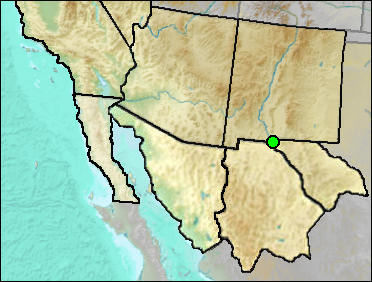 Age. Irvingtonian.
Age. Irvingtonian.
General Description. River sands and gravels along the eastern side of the Franklin Mountains and along the Rio Grande. These presumably are Irvingtonian in age. Most specimens are from sand and gravel pits or from construction. Includes material from several sites within the city limits, including from "Rous's gravel pit at the head of North Virginia street" (Richardson 1909).
Discussion. Valley fill, both from along the current pathway of the Rio Grande and from the abandoned ancestral Rio Grande drainage east of the Franklin Mountains, ranges from Blancan to Irvingtonian in age. River gravels and sand deposits are commercially mined, with fossils recovered from time to time.
The fossil material reported by Richardson (1909) had been identified by Gidley at the U.S. National Museum. If the faunal elements are Irvingtonian, as is by far the most likely, Gidley's identification of the mammoth probably is incorrect, and the identification given here is to genus only.
Fauna
Gopherus—Gopherus Tortoise (UTEP: ?)
†Mammuthus sp.—Mammoth (Richardson 1909: Mammuthus
columbi)
†Mammut americanum—American Mastodont (UTEP)
†Stegomastodon mirificus—Wonderful Stegodont (UTEP)
†Glyptotherium arizonae—Gidley's Glyptodont (UTEP)
†Canis armbrusteri—Armbruster's Wolf (UTEP)
†Equus sp.—Horse (Richardson 1909: Equus complicatus)
†Equus calobatus—Stilt-legged Onager (UTEP)
†Tapirus haysii—Hay's Tapir (Richardson 1909: ?)
†Camelops sp.—American Camel (UTEP)
†Hemiauchenia sp.—American Llama (UTEP: cf.)
Cervidae—Deer (UTEP)
Literature. Richardson 1909
Last Update: 9 May 2009